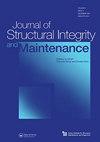一种防止风力涡轮机叶片前缘侵蚀的新解决方案
IF 3.1
Q2 ENGINEERING, CIVIL
Journal of Structural Integrity and Maintenance
Pub Date : 2021-07-03
DOI:10.1080/24705314.2021.1906091
引用次数: 0
摘要
在过去的30年里,风能已经成为可再生能源的主要形式之一。随着行业的发展,风力涡轮机本身的规模也在增长——大型风力涡轮机现在可以产生高达15兆瓦的电力。然而,更大的涡轮机带来了额外的结构挑战需要克服,其中一个挑战是在叶片的高叶尖速度下,由于水的冲击,沿叶片前缘的侵蚀。因此,本文提出了一种防止风力涡轮机叶片前缘侵蚀的新解决方案。首先,本文描述了在LEP开发过程中进行的实验测试活动。根据所选材料的雨蚀试验结果及其可制造性和其他力学性能,选择热塑性聚氨酯作为制造LEP的最合适材料。LEP组件通过验证测试降低了风险,然后连接到全尺寸风力涡轮机叶片的前缘。对叶片进行了结构(动态、静态和疲劳力学)测试,未观察到明显的损伤。下一阶段的开发是在海上条件下对风力涡轮机进行操作试验。本文章由计算机程序翻译,如有差异,请以英文原文为准。
A novel solution for preventing leading edge erosion in wind turbine blades
ABSTRACT Over the past 30 years, wind energy has been established as one of the leading forms of renewable energy. As the industry grows so too does the size of the wind turbines themselves – large wind turbines can now generate up to 15 MW. However, with larger turbines comes additional structural challenges to overcome, where one such challenge is erosion along the leading edge of the blade due to water impingement at the higher tip speeds of the blade. Therefore, in this paper, the development of a novel solution for preventing leading edge erosion on wind turbine blades (LEP) is presented. Primarily, this paper describes the experimental testing campaigns that were performed during LEP development. Based on the results from the rain erosion testing of selected materials, their manufacturability and other mechanical properties, thermoplastic polyurethane has been selected as the most suitable material to manufacture the LEP. The LEP component was de-risked through demonstrator testing and then bonded to the leading edge of a full-scale wind turbine blade. Structural (dynamic, static and fatigue mechanical) testing was performed on the blade with no significant damage observed. The next stage of development is operational trials on a wind turbine in marine conditions.
求助全文
通过发布文献求助,成功后即可免费获取论文全文。
去求助
来源期刊

Journal of Structural Integrity and Maintenance
ENGINEERING, CIVIL-
CiteScore
3.90
自引率
9.50%
发文量
24
 求助内容:
求助内容: 应助结果提醒方式:
应助结果提醒方式:


